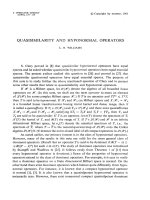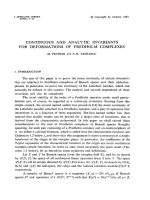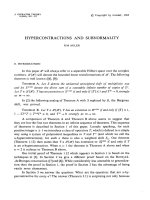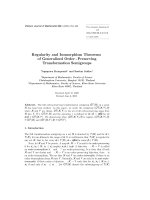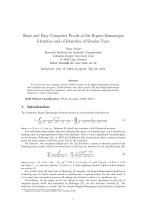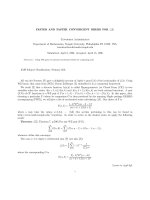Báo cáo toán học: " Short and Easy Computer Proofs of the Rogers-Ramanujan Identities and of Identities of Similar Type" pdf
Bạn đang xem bản rút gọn của tài liệu. Xem và tải ngay bản đầy đủ của tài liệu tại đây (161.8 KB, 9 trang )
Short and Easy Computer Proofs of the Rogers-Ramanujan
Identities and of Identities of Similar Type
Peter Paule
∗
Research Institute for Symbolic Computation
Johannes Kepler University Linz
A–4040 Linz, Austria
Submitted: July 15, 1994; Accepted: July 26, 1994.
Abstract
New short and easy computer proofs of finite versions of the Rogers-Ramanujan identities
and of similar type are given. These include a very short proof of the first Rogers-Ramanujan
identity that was missed by computers, and a new proof of the well-known quintuple product
identity by creative telescoping.
AMS Subject Classification. 05A19; secondary 11B65, 05A17
1 Introduction
The celebrated Rogers-Ramanujan identities stated as series-product identities are
1+
∞
k=1
q
k
2
+ak
(1 − q)(1 − q
2
) ···(1 − q
k
)
=
∞
j=0
1
(1 − q
5j+a+1
)(1 − q
5j−a+4
)
(1)
where a =0ora = 1, see e.g. Andrews [6] which also contains a brief historical account.
It is well-known that number theoretic identities like these, or of similar type, can be deduced as
limiting cases of q-hypergeometric finite-sum identities. Due to recent algorithmic breakthroughs,
see for instance Zeilberger [24], or, Wilf and Zeilberger [23], proving these finite versions becomes
more and more routine work that can be left to the computer.
For instance, the computers Ekhad and Tre [12] delivered a purely verification proof of the
following finite version, which was stated first in this form by Andrews [3], see also Bressoud [10].
k
q
k
2
(q; q)
k
(q; q)
n−k
=
k
(−1)
k
q
(5k
2
−k)/2
(q; q)
n−k
(q; q)
n+k
, (2)
where (a; q)
n
=(1− a)(1−aq) ···(1 −aq
n−1
)forn ≥ 1, (a; q)
0
=1,and1/(q; q)
n
=0forn<0. In
the limit n →∞one gets identity (1) with a = 0, after applying Jacobi’s triple product identity,
see section 5.1.
It is evident that the hard part of deducing, for instance, the Rogers-Ramanujan identities as
a limiting case of a finite version consists in finding such a representation. On the other hand, it
is to expect that automated proving will enlarge the heuristic toolbox in a significant way.
Nevertheless, in this paper we do not intend to enter the recent discussion on the rˆole of
computer proofs, which was stimulated by Zeilberger [27], see also Andrews’ rebuttal [9]. The
objective of this paper is to show that for classical Rogers-Ramanujan type identities, computers
∗
Supported in part by grant P7220 of the Austrian FWF
1
the electronic journal of combinatorics 1 (1994), # R10 2
are able to produce ”nice” proofs, i.e. not kind of Byzantine computer output a human usually
is unwilling, or even unable, to verify. In the particular situations of this article it turns out that
even the computer-constructed proof certificates are amenable to human verification.
The paper is organized as follows. In section 2 we are going to specify our use of the notion
”computer proof”. A computer proof of a q-hypergeometric identity will be understood as a proof
by qWZ-certification, based on the method of creative telescoping.
Insection3wepresentanew”veryshort”qWZ-certification proof of (2) that was missed by
the computers Ekhad and Tre [12].
In section 4 we provide the qWZ-certificate of another finite Rogers-Ramanujan version due to
Andrews [2] and which originates in the work of Schur [21], who independently discovered (1). As
briefly indicated in section 4, this finite version plays an outstanding rˆole for certain applications
in physics.
Besides the versions given in Andrews [8], all known finite Rogers-Ramanujan type identities
deliver the product-side only after applying expansion formulas like the triple or the quintuple
product identities. In section 5, for sake of completeness, qWZ-certificates of corresponding finite
versions are presented.
In section 6 we briefly comment on the newly developed computer program we used to find the
proof certificates in this paper.
2
q
WZ-certification
Analogous to the algorithm presented by Zeilberger [25], the computer program we used takes
terminating q-hypergeometric sums as input. Its output is a linear recurrence that is satisfied by
the input sum, together with a rational function serving as a proof certificate. As made explicit in
this section, verifying the recurrence is equivalent to checking a rational function identity.
Let f := (f
n,k
) be a double-indexed sequence with values in a suitable (e.g. computable)
ground-field F containing the rational number field and q. In the following we consider q as an
indeterminate, which could be specialized to a nonzero complex number (with |q| < 1 for limit
considerations). We shall consider only sequences where n runs through the nonnegative integers,
whereas the second parameter k might run through all integers.
The sequence f is called q-hypergeometric in both parameters if both quotients
f
n,k
f
n−1,k
and
f
n,k
f
n,k−1
are rational functions in q
n
and q
k
over F for all n and k where the quotients are well-defined. For
instance, if [l]:=(1− q
l
)/(1 − q) for integer l,and
n
k
:=
k
l=1
[n − l +1]
[l]
,if0≤ k ≤ n
0,otherwise
are the Gaussian polynomials, then
n +1
k +1
/
n
k +1
=
1 − q
n+1
1 − q
n−k
and
n +1
k +1
/
n +1
k
=
1 − q
n−k+1
1 − q
k+1
.
For q =1(resp. q → 1) the Gaussian polynomial
n
k
turns into
n
k
, the ordinary binomial
coefficient.
We say the sequence f has finite support with respect to k, if the following is true for each n
fixed: f
n,k
=0forallk from a finite integer interval I
n
,andf
n,k
=0forallk outside I
n
.Asimple
example for such a sequence is provided by f
n,k
:=
n
k
where I
n
= {0, 1, ,n}.
Given a sequence (f
n,k
)beingq-hypergeometric in both parameters and having finite support
with respect to k. For nonnegative integer n define S
n
:=
k
f
n,k
, a finite sum due to finite
support property. We use the convention that the summation parameter k runs through all the
integers, in case the summation range is not specified explicitly.
the electronic journal of combinatorics 1 (1994), # R10 3
Alternatively, the sequence S := (S
n
) can be represented in terms of a recursion of some order
d. For instance, as the unique solution of the recurrence
c
0
(n)S
n
+ c
1
(n)S
n−1
+ ···+ c
d
(n)S
n−d
=0 (3)
for n ≥ d, with certain coefficients c
i
(n), c
0
(n) = 0, and with respect to the initial values
S
0
,S
1
, ,S
d−1
. Equivalently, the annihilating operator
A
S
(N):=
d
l=0
c
l
(n)N
−l
, (4)
where N denotes the shift-operator with respect to n, together with the d initial values represent
S in a unique way.
Let f and S be as above, then the qWZ-certificate of the annihilating operator is by definition
a rational function cert
S
(n, k), rational in q
n
and q
k
, such that
A
S
(N)f
n,k
= g
n,k
− g
n,k−1
(5)
where
g
n,k
:= cert
S
(n, k) f
n,k
. (6)
We shall use this type of certification following Wilf’s and Zeilberger’s paradigm of ”creative
telescoping”, see e.g [26], [22] or [23]. Namely, given S in sum representation as above, the qWZ-
certificate contains all information necessary to prove that S satisfies the homogeneous recursion
described by the operator A
S
(N). This is true, because summing (5) over sufficiently many k,
i.e. over an integer interval containing the finite support such that the bounds evaluate to zero,
immediately implies (3). Thus what is left is to verify (5). But this is equivalent to checking a
rational function identity, i.e.
r(n, k)=cert
S
(n, k) − cert
S
(n, k − 1)
f
n,k−1
f
n,k
(7)
where r(n, k), rational in q
n
and q
k
, comes from
A
S
(N)f
n,k
= r(n, k) f
n,k
.
The actual computation of r(n, k) is straightforward from rewriting the N
−l
actions as rational
function multiples of f
n,k
,i.e.
N
−1
f
n,k
=
f
n−1,k
f
n,k
f
n,k
,N
−2
f
n,k
=
f
n−2,k
f
n−1,k
f
n−1,k
f
n,k
f
n,k
, a.s.o.
3 A Computer Proof that was Missed by Computers
Ekhad and Tre [12] gave a qWZ-certification proof of (2) by showing that both sides are solutions
of a certain fifth order linear recurrence equation. More precisely, they showed that the left hand
side is annihilated by a recurrence operator of order two, whereas the right hand side by a fifth
order multiple of that operator. What Ekhad and Tre missed observing is that both sides of a slight
variation of the original form of identity (2) satisfy indeed the same recurrence of order two. This
variation makes use of the summand’s symmetry. It consists in introducing an extra factor 1 + q
k
in the summand of the right hand side, which, because of symmetry in k and −k, amounts to the
same as multiplying the sum by 2. This is made more transparent if we look at the decomposition
of the summand f(k) into its even and its odd part, in the usual way,
f(k)=f
e
(k)+f
o
(k)=
f(k)+f(−k)
2
+
f(k) − f(−k)
2
.
Summing over all integers the sum of the odd parts obviously vanishes and it is true that
k
f(k)=
k
f
e
(k)=
k
f(k)+f(−k)
2
.
the electronic journal of combinatorics 1 (1994), # R10 4
Theorem 1 For nonnegative integers n:
k
2q
k
2
(q; q)
k
(q; q)
n−k
=
k
(−1)
k
(1 + q
k
)q
(5k
2
−k)/2
(q; q)
n−k
(q; q)
n+k
. (8)
In addition, both sides are annihilated by
A(N):=(1− q
n
)N
0
− (1 + q − q
n
+ q
2n−1
)N
−1
+ qN
−2
. (9)
Proof: Denote the left hand side of (8) by L(n), the right hand side by R(n). Since the initial
values coincide,
L(0) = R(0) = 2 and L(1) = R(1) = 2
1+q
1 − q
, (10)
it suffices to prove that both sides are annihilated by A(N). But this follows, as explained in
section 2, from the corresponding qWZ-certificates:
cert
L
(n, k)=−q
2n−1
(1 − q
n−k
) (11)
and
cert
R
(n, k)=
q
2n+3k
1+q
k
(1 − q
n−k
). (12)
Remark: We want to point out that all computational steps needed to verify the proof are
indeed of ”human” size, i.e. they can be carried out by hand without too much pain in a reasonable
amount of time. (The verification of this statement is left to the reader.)
From a q-hypergeometric point of view (2) is a terminating special instance of Watson’s q-
analogue of Whipple’s theorem, see e.g. Gasper and Rahman [13], (III.18). The successful varia-
tion, i.e. the idea of introducing the extra factor 1 + q
k
, stems from the (human) author’s study,
in interaction with the computer, of various terminating cases of Watson’s q-analogue.
The introduction of the extra factor 1 + q
k
or, more generally, summing the even part turns
out to be crucial for boiling down qWZ-certificates of many more finite identities of similar type.
More precisely, in these instances the telescoping equation (5) finds a solution for an annihilating
operator of smaller degree than for the original summand.
For example:
• Without introducing the extra symmetry factor 1 + q
−k
,therighthandsideof(1.1)in
Bressoud [11], another finite version of (1, a = 0), has minimal recursion order 5, instead of
2, with respect to qWZ-certification. Analogous observations hold for all other finite versions
of Rogers-Ramanujan type identities presented in [11].
• Without introducing the extra symmetry factor 1 + q
2k
, the left hand side of (55) in Paule
[17], a finite version of a Goellnitz-Gordon identity, has minimal recursion order 4, instead
of 2, with respect to qWZ-certification.
• Without introducing the extra symmetry factor 1 + q
k
, the left hand side of (48) in Paule
[17], a finite version of a Rogers-Selberg identity, has minimal recursion order 7 (!), instead
of 3, with respect to qWZ-certification.
4 The Andrews-Schur Identity
As observed by Andrews [2], the following polynomial identity for a = 0 and a = 1 immediately
implies (1) by taking n →∞and using Jacobi’s triple product identity (see the next section).
the electronic journal of combinatorics 1 (1994), # R10 5
n
k=0
q
k
2
+ak
2n − k + a
k
= (13)
∞
k=−∞
q
10k
2
+(4a−1)k
2n +2a +2
n − 5k
[10k +2a +2]
[2n +2a +2]
.
(This corresponds to α =0andn → 2n − 1, or, α = −1andn → 2n in the theorem of [2], cf.
also (3.10) and (3.12) in Andrews [8].)
As pointed out by Andrews [2], this finite version of (1) has its origin in the work of Schur [21].
The importance of (13) comes from the fact that it describes q → q
−1
duality of regimes of R.J.
Baxter’s solution to the hard hexagon model of statistical mechanics, see e.g. Andrews [5] or [7].
With respect to creative telescoping it turns out that the following reciprocal variant of (13)
finds nicer qWZ-certificates than the identity in its original form.
Theorem 2 For a =0or a =1:
n
k=−a/2
q
k
2
+2ak
n + k + a
n − k
=
n/5
k=−(n+2a+2)/5
q
15k
2
+(6a+1)k
2n +2a +2
n − 5k
[10k +2a +2]
[2n +2a +2]
. (14)
Proof: Denote the left hand side of (14) by L
(a)
(n), the right hand side by R
(a)
(n). In view of
L
(a)
(0) = R
(a)
(0) = 1 and L
(a)
(1) = R
(a)
(1) = [a +1]+q
2a+1
(15)
it suffices to prove that both sides are annihilated by
A
(a)
(N):=N
0
− (1 + q + q
2n+2a−1
)N
−1
+ qN
−2
. (16)
But this follows, as explained in section 2, from the corresponding qWZ-certificates:
cert
L
(a)
(n, k)=−q
2n+2a−1
[n − k]
[n + k + a]
(17)
and
cert
R
(a)
(n, k)=−q
2n+20k+6(a+1)
(18)
[n − 5k − 4][n − 5k − 3][n − 5k − 2][n − 5k − 1][n − 5k]
[10k +2a +2][2n +2a − 2][2n +2a − 1][2n +2a][2n +2a +1]
.
Remark: (i) It is interesting to note that both sides of (14) are annihilated by the same operator
(16) for all nonnegative integers a. But only for the specific choices a =0ora = 1 the initial
values of the sums match.
(ii) For combinatorial interpretations of the finite sums arising in (13) and (14) see, for instance,
Agarwal and Andrews [1].
Identity (14) is the reciprocal dual of (13). This can be seen, for instance, as follows. On the
left hand side of (13) reverse the order of summation, i.e. k → n −k. The rest follows immediately
by q → q
−1
using the well-known fact that Gaussian polynomials are reciprocal, i.e.
n
m
q→q
−1
= q
m(m−n)
n
m
.
In concluding this section we note that, in contrast to other finite versions of (1), the Andrews-
Schur identity finds a nontrivial specialization for q = 1. Namely, for q = 1 both identities (13)
and (14) turn into the binomial identity (a =0ora =1)
n
k=−a/2
n + k + a
n − k
=
n/5
k=−(n+2a+2)/5
2n +2a +2
n − 5k
5k + a +1
n + a +1
. (19)
the electronic journal of combinatorics 1 (1994), # R10 6
For a = 0 (resp. a = 1) this corresponds to two different binomial sum representations of the
even (resp. odd) Fibonacci numbers. That can be seen, for instance, directly from the defining
recursion (16) for q = 1, and the first two initial values. For integer a>1 identity (19) results in nice
Fibonacci relations which group together mod 5. More precisely, let l(n, a)(resp. r(n, a)) denote
the left (resp. right) side of (19) and let (F (k))
k≥0
be the Fibonacci sequence with F (0) = F(1) = 1.
Then for all nonnegative integers a, m, n we have l(n, a)=F (2n +a)andr(n, 5m)=F(10m+2n),
r(n, 5m+1) = F(10m+2n+1), r(n, 5m+2) = −F (10m+2n+3), r(n, 5m+3) = −F (10m+2n+6),
and r(n, 5m +4)=0.
5 Triple and Quintuple Product Expansions
Besides those ones given in Andrews [8], all known finite Rogers-Ramanujan type identities deliver
the product-side only after applying expansion formulas like the triple or the quintuple product
identities. For sake of completeness, we present qWZ-certificates of corresponding finite versions.
Version (27) for the quintuple product identity seems to be stated the first time in this form.
5.1 Jacobi’s Triple Product Identity
It is well-known, see e.g. Andrews [6], that Jacobi’s triple product identity
∞
k=−∞
q
(
k
2
)
x
k
=
∞
j=1
(1 − q
j
)(1 + x
−1
q
j
)(1 + xq
j−1
) (20)
can be deduced, for instance, as a limiting case n →∞of the following finite variant of the
q-binomial theorem.
Theorem 3
For nonnegative integers n and x =0:
k
2n
n + k
q
(
k
2
)
x
k
=(−x
−1
q; q)
n
(−x; q)
n
. (21)
In addition, both sides are annihilated by
A(N)=N
0
− (1 + x
−1
q
n
)(1 + xq
n−1
)N
−1
. (22)
Proof: Denote the sum by L(n). It suffices to prove that both sides of (21) evaluate to 1 for
n = 0, and are annihilated by A(N). The nontrivial part follows, as explained in section 2, from
the corresponding qWZ-certificate:
cert
L
(n, k)=q
n−1
[n − k](q
k+1
[n − k − 1] − x[n + k])
[2n − 1][2n]
. (23)
Application: It is easy to see that in the limit n →∞the left hand side of (13) tends to the
left hand side of (1), whereas the right hand side tends to
1
(q; q)
∞
∞
k=−∞
q
10k
2
+(4a−1)k
(1 − q
10k+2a+2
), (24)
where (a; q)
∞
=
∞
j=0
(1 − aq
j
).
This can be rewritten as
1
(q; q)
∞
∞
k=−∞
(−1)
k
q
(5k
2
+(4a−1)k)/2
, (25)
which turns into the product side of (1) after applying (20) with q → q
5
and x →−q
2a+2
.
the electronic journal of combinatorics 1 (1994), # R10 7
5.2 The Quintuple Product Identity
A standard form of the quintuple identity reads as (z =0):
∞
k=−∞
(−1)
k
q
(3k
2
−k)/2
z
3k
(1 + zq
k
) = (26)
∞
j=1
(1 − q
j
)(1 + z
−1
q
j
)(1 + zq
j−1
)(1 + z
−2
q
2j−1
)(1 + z
2
q
2j−1
),
see, for instance, Gasper and Rahman [13] (Ex. 5.6, together with the references).
Again we prove (26) as a limiting case.
Theorem 4 For nonnegative integers n and w =0:
k
(−1)
k
q
(3k
2
+k)/2
w
3k
2n
n + k
1 − w
2
q
2k+1
(w
−2
; q)
n−k
(w
2
q
2
; q)
n+k
= (27)
1 − w
2
q
(w
−1
; q)
n
(wq; q)
n
.
In addition, both sides are annihilated by
A(N)=N
0
− (1 − w
−1
q
n−1
)
−1
(1 − wq
n
)
−1
N
−1
. (28)
Proof: Denote the sum by L(n), which is defined over a q-hypergeometric summand sequence
having finite support with respect to k. It suffices to prove that both sides of (27) evaluate to
1 − w
2
q for n = 0, and are annihilated by A(N). The nontrivial part follows, as explained in
section 2, from the corresponding qWZ-certificate:
cert
L
(n, k)=wq
n+2k
(1 − w
−2
q
n−k−1
)(1 − wq
k+1
)
(1 − w
−1
q
n−1
)(1 − w
2
q
2k+1
)(1 − wq
n
)
×
[n − k]([n − k − 1] − wq
n
[2n − 1] + w
2
q[n + k])
[2n][2n − 1]
.
(29)
For n →∞in (27) we get the identity, first stated by G.N. Watson,
k
(−1)
k
q
(3k
2
+k)/2
w
3k
(1 − w
2
q
2k+1
)=
(q; q)
∞
(w
−2
; q)
∞
(w
2
q; q)
∞
(w
−1
; q)
∞
(wq; q)
∞
, (30)
which is easily seen to be equivalent to (26).
Remark: Identity (27) is a a terminating version of a very-well-poised
6
ψ
6
identity due to W.N.
Bailey. We derived it following Andrews’ proof of (26) given in [4].
Application: Taking the limit n →∞in (26) and applying the quintuple product identity to
the right hand side series
1
(q; q)
∞
∞
k=−∞
q
15k
2
+(6a+1)k
(1 − q
10k+2a+2
), (31)
the reciprocal Andrews-Schur identity (14) becomes (a =0ora =1)
∞
k=0
q
k
2
+2ak
(q; q)
2k+a
=
∞
j=0
1
(1 − q
2j+1
)(1 − q
20j+4a+4
)(1 − q
20j−4a+16
)
. (32)
These are identities due to L.J. Rogers, see e.g. Agarwal and Andrews [1].
the electronic journal of combinatorics 1 (1994), # R10 8
6Conclusion
All qWZ-certificates presented in this paper have been found by a computer program which is a
q-analogue of Zeilberger’s ”fast” algorithm for proving terminating hypergeometric identities, see
Zeilberger [25]. The program is written in Mathematica by Riese [20]. The algorithmic backbone
of the program is a q-analogue of Gosper’s algorithm [14], see also Graham, Knuth and Patashnik
[15], based on recent work of the author [18]. After completion the program will be available upon
request.
Riese’s package is not the first implementation of a q-analogue of Zeilberger’s ”fast” algorithm.
There are Maple programs written by Zeilberger, cf. [12], and Koornwinder [16]. In [16], one can
also find a rigorous description of the algorithmic background of Koornwinder’s implementation.
We want to conclude with a short example concerning the performance of Riese’s program.
With respect to Watson’s q-analogue of Whipple’s theorem, see e.g. Gasper and Rahman [13]
(III.18), Ekhad and Tre [12] remarked that their memories did not suffice for coming up with a
qWZ-certification proof. With Riese’s program one needs approximately 10 minutes on an Apollo
4500 workstation for obtaining the certificates (of order 2) of both sides. The qWZ-certificates
presented in this paper are obtained in about 60 seconds or less. A more detailed discussion of
algorithmic background, performance, and examples will be given in paper by the author and Riese
[19].
Acknowledgment
: The author thanks Volker Strehl, Herb Wilf and Doron Zeilberger for valuable
suggestions and comments.
References
[1] A.K. Agarwal and G.E. Andrews, Hook differences and lattice paths, J. Stat. Planning and
Inference,
14
(1986), 5–14.
[2] G.E. Andrews, A polynomial identity which implies the Rogers-Ramanujan Identities, Scripta.
Math., 28 (1970), 297–305.
[3] G.E. Andrews, Problem 74-12,SIAMRev.,
16
(1974), 390.
[4] G.E. Andrews, Applications of basic hypergeometric functions,SIAMRev.,
16
(1974), 441-484.
[5] G.E. Andrews, The hard-hexagon model and Rogers-Ramanujan type identities,Proc.Natl.
Acad. Sci. USA,
78
(1981), 5290–5292.
[6] G.E. Andrews, The Theory of Partitions, Encyclopedia of Mathematics and its Applications
Vol.2, G C. Rota ed., Addison-Wesley, Reading, 1976 (Reissued: Cambridge University Press,
London and New York, 1985).
[7] G.E. Andrews, q-Series: Their Development and Application in Analysis, Number Theory,
Combinatorics, Physics, and Computer Algebra, CBMS Regional Conference Series, No. 66,
American. Math. Soc., Providence, 1986.
[8] G.E. Andrews, The Rogers-Ramanujan identities without Jacobi’s triple product, Rocky Moun-
tain J. Math.,
17
(1987), 659–672.
[9] G.E. Andrews, The death of proof ? Semi-rigorous mathematics? You’ve got to be kidding!,
Math. Intelligencer, to appear.
[10] D.M. Bressoud, Solution of Problem 74-12,SIAMRev.,
23
(1981), 101–104.
[11] D.M. Bressoud, Some identities for terminating q-series, Math. Proc. Camb. Phil. Soc.,
89
(1981), 211–223.
[12] S.B. Ekhad and S. Tre, A purely verification proof of the first Rogers-Ramanujan identity,J.
Comb. Th. (A),
54
(1990), 309–311.
the electronic journal of combinatorics 1 (1994), # R10 9
[13] G. Gasper and M. Rahman, Basic Hypergeometric Series, Encyclopedia of Mathematics and
its Applications Vol.35, G C. Rota ed., Cambridge University Press, London and New York,
1990.
[14] R.W. Gosper, Decision procedures for indefinite hypergeometric summation,Proc.Natl.Acad.
Sci. USA., 75, 40–42.
[15] R. Graham, D. Knuth and O. Patashnik, Concrete Mathematics, A Foundation for Computer
Science. Addison-Wesley, 1989.
[16] T.H. Koornwinder, On Zeilberger’s Algorithm and its q-analogue, J. of Comput. and Appl.
Math., 48 (1993), 91–111.
[17] P. Paule, On identities of the Rogers-Ramanujan type, J. Math. Anal. Appl., 107 (1985),
255–284.
[18] P. Paule, Greatest-Factorial Factorization and Symbolic Summation I, RISC-Linz Report Se-
ries No. 93-02 (submitted to J. Symb. Computation).
[19] P. Paule and A. Riese, A Mathematica version of Zeilberger’s Algorithm for proving terminat-
ing q-hypergeometric series identities, in preparation.
[20] A. Riese, A Mathematica q-analogue of Zeilberger’s algorithm for proving q-hypergeometric
identities, diploma thesis, in preparation.
[21] I. Schur, Ein Beitrag zur additiven Zahlentheorie und zur Theorie der Kettenbr¨uche,S B.
Preuss. Akad. Wiss. Phys Math.Kl. (1917) 302–321. (Reprinted: Gesammelte Abhandlungen,
Vol.2, Springer, Berlin (1973), 117–136.
[22] H.S. Wilf and D. Zeilberger, Rational function certification of multisum/integral/‘q’identities,
Bull. Amer. Math. Soc. (N.S.), 27 (1992), 148–153.
[23] H.S. Wilf and D. Zeilberger, An algorithmic proof theory for hypergeometric (ordinary and
”q”) multisum/integral identities, Invent. Math., 108 (1992), 575–633.
[24] D. Zeilberger, A holonomic systems approach to special function identities, J. Comp. Appl.
Math., 32 (1990), 321–368.
[25] D. Zeilberger, A fast algorithm for proving terminating hypergeometric identities, Discr. Math.,
80 (1990), 207–211.
[26] D. Zeilberger, The method of creative telescoping, J. Symb. Computation, 11 (1991), 195–204.
[27] D. Zeilberger, Theorems for a price: tomorrow’s semi-rigorous mathematical culture, Notices
of the A.M.S., 40 (1993), 978–981.
